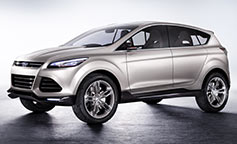- Ford Vertrek compact sport utility vehicle (SUV) concept showcases key elements of the company’s evolving global kinetic design philosophy
- Kinetic design communicates a fun-to-drive experience through stance, flowing lines and implied muscularity and advanced technology and craftsmanship through exquisite detailing
- The sleeker, sportier shape of Vertrek concept is immediately communicated through aggressive lower grille treatment, faster roofline and rising beltline with rear kickup
 March 1, 2011 – Ford’s continually evolving global kinetic design philosophy is well-suited to the next generation of compact sport utility vehicles (SUVs) as envisioned by the Ford Vertrek concept unveiled at the 2011 Geneva Motor Show.
March 1, 2011 – Ford’s continually evolving global kinetic design philosophy is well-suited to the next generation of compact sport utility vehicles (SUVs) as envisioned by the Ford Vertrek concept unveiled at the 2011 Geneva Motor Show.
“The world is changing and consumers are looking for a new compact SUV,” said Martin Smith, Executive Design Director, Ford of Europe. “They work and play hard and desire a vehicle that not only,reflects this outlook on life, but also stands out in the crowd. We believe the Vertrek concept will fulfill what they’re looking for.”
The core goal of kinetic design is to create vehicles that imply motion even when standing still and convey Ford’s excellent driving dynamics.
“The building blocks of kinetic design – defining the stance and how the body is set over the wheels; strong and precisely executed surfacing; the dynamic, expressive lines and creating a sleeker aerodynamic profile – are all very much in line with what we believe customers want in future compact SUVs,” said Smith.
The Vertrek concept takes its inspiration from the Ford Kuga, hailed as the design leader in its segment, and takes the promise of a future global compact SUV to the next level.
The new model combines a sleeker and sportier design intelligently with increased interior cargo capability.
“Overall, the Vertrek concept is a sleeker, sportier and smarter representation of what customers want in a compact SUV,” he added. “Additionally, the exquisite detailing, such as the execution of the headlamps, taillamps and wheels, evokes advanced technology and craftsmanship.”
The exterior colour is Liquid Platinum, chosen to bring out the strong sculpturing of Vertrek while stressing the sophistication and premium execution of the vehicle’s personality.
Key exterior design attributes of the Ford Vertrek concept include:
Lower trapezoidal grille: A key kinetic design cue, now divided into three sections as first seen with the new Ford Focus, immediately identifies Vertrek as the latest Ford
Slimmer headlamp and taillamp treatment: Highlights the advanced technology, craftsmanship and detailing throughout the vehicle
Hood: Muscular surfacing signals advanced powertrain solutions
Faster roofline: Sleek look conveys improved aerodynamics and fuel efficiency
Rising beltline: Conveys dynamic presence
Wheel arches: Create solid, athletic stance
Wheels: Combine bold sportiness with lightweight appeal
Panoramic roof: Graphically linked to the rear glass by the dramatic rear spoiler
“Based on the reception of the Fiesta and all-new Focus models, customers are excited by our new global design strategy, so it makes absolute sense to offer kinetic design in our next generation of compact utility vehicles as well," he said.
Sporty, sophisticated and roomy interior
The Vertrek concept interior is lightweight and spacious and conveys all the expressive flair evident in the exterior.
As the focal point of the interior, the instrument panel displays shapes and forms that are absolutely unique, and further demonstrates Ford’s kinetic design language. The wing-like profile spans the cockpit and visually extends through the side glass into the rear view camera. The center console swoops into the interior and develops into a central bridge flowing through the vehicle.
The theme of sophisticated craftsmanship is evident throughout the interior, including the instrument panel wrapped in Dusk Grey leather, contrasted and cooled by the satin-tinted platinum tones of the center console. The fluorescent detailing comes as a surprising highlight.
The execution of the four individual seats communicates sportiness and relaxation. The slim seats are clad in naturally tanned, velour leather and, says Smith, “have the robust quality of Bavarian lederhosen.” This is offset throughout the interior by the modernistic touch of neon red-orange fluorescent highlights – an intriguing combination of traditional and high-tech. The seats are of slim construction, showcased by the central spine support.
Replacing conventional carpet, Vertrek concept incorporates handcrafted woven-leather floor materials. Functional elements on the steering wheel, doors, cluster and instrument panel have a polished, premium finish that demonstrates craftsmanship normally seen on premium products.
Summing up the new concept model, Martin Smith said, “The Ford Vertrek concept brings new excitement to the global crossover and compact SUV arena and is our vision of how kinetic design can redefine this increasingly popular segment for Ford globally. The very name Vertrek signals versatility and capability, typifying the personality of the revolution in this market.”
# # #
About Ford Motor Company
Ford Motor Company, a global automotive industry leader based in Dearborn, Mich., manufactures or distributes automobiles across six continents. With about 164,000 employees and about 70 plants worldwide, the company’s automotive brands include Ford and Lincoln. The company provides financial services through Ford Motor Credit Company. For more information regarding Ford’s products, please visit www.fordmotorcompany.com.
Ford of Europe is responsible for producing, selling and servicing Ford brand vehicles in 51 individual markets and employs approximately 66,000 employees. In addition to Ford Motor Credit Company, Ford of Europe operations include Ford Customer Service Division and 22 manufacturing facilities, including joint ventures. The first Ford cars were shipped to Europe in 1903 – the same year Ford Motor Company was founded. European production started in 1911.

